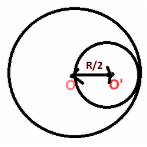Question
Question: From a uniform disk of radius \({\text{R}}\), a circular hole of radius \(\dfrac{{\text{R}}}{2}\) is...
From a uniform disk of radius R, a circular hole of radius 2R is cut out. The centre of the hole is at 2R from the centre of the original disc. Locate the centre of gravity of the resulting flat body.
Solution
Hint: Assume that the mass per unit area of the uniform disc is σ therefore the mass of the uniform disc is M = σπR2 and the mass of the small disc is σπ(2R)2=4σπR2=4M
Formula used:
x = (m1 + m2)(m1r1 + m2r2)
where x is the distance through which the centre of gravity of the remaining portion shifts
and m1,r1 are the mass & radius of uniform disc and m2,r2 are the mass & radius of the small disc that has been cut.
Complete step-by-step solution -
__
Given that,
Radius of uniform disc =R
Radius of the smaller disc =2R
Let the mass per unit area of the original disc =σ
Therefore mass of the uniform disc =M = σπR2
And the mass of the small disc = σπ(2R)2=4σπR2=4M
Now as the small disc has been cut from the uniform disc, the remaining portion is considered to be a system of two masses.
The two masses are: M (concentrated at O) & −M(concentrated at O')
(negative sign indicating above that the portion is removed from the uniform disc)
Let x be the distance through which the centre of mass of the remaining portion shifts from point O.
The relation between the centre of masses of two masses is give as:
x = (m1 + m2)(m1r1 + m2r2) x = (M - 4M)[(M×0 - 4M)×(2R)] =(43M)(8−MR) =24−4R x = 6−R .
Note: The relation between the centre of masses of two masses is calculated by the formula x = (m1 + m2)(m1r1 + m2r2) which is found to be 6−R here the negative sign indicates that the centre of gravity of the resulting flat body gets shifted towards the left point O.
